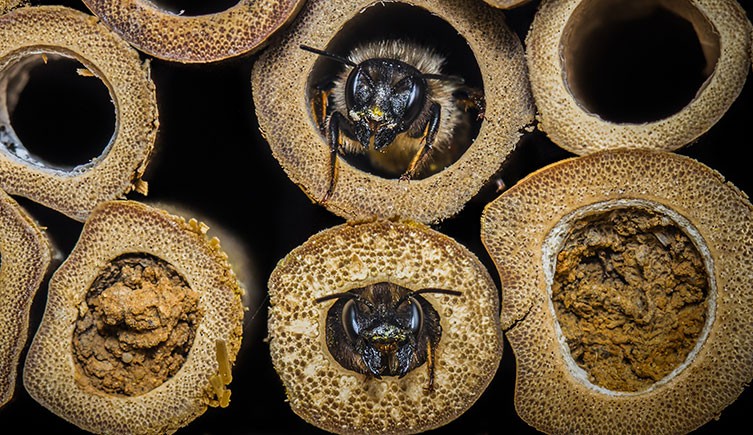Bee hotels have become popular additions to gardens, designed to support wild bees by providing them with nesting sites. Solitary bees, unlike honey bees, live in natural and man-made cavities which can be easily provided with nesting habitats. A previously published Garden Professors blog offers valuable insights into creating artificial nesting structures for these bees, emphasizing the importance of proper design and placement. However, if you’re thinking about installing a bee hotel, I’d urge you to reconsider – some studies suggest that bee hotels, if not correctly maintained, can inadvertently harm the very pollinators they’re meant to help.
While bee hotels offer nesting opportunities, there is almost no research showing that they have a positive effect on bees. Some researchers also think bee hotels can become hotspots for parasites and pathogens (MacIvor & Packer 2015). High-density nesting sites can facilitate the spread of diseases, similar to how bird feeders can become transmission points for avian illnesses. Bees are particularly vulnerable to viruses, microsporidians, and fungal agents which can spread via exposure to feces or even through pollen left behind by bee visitors. Bee hotels can also attract bee predators – nesting aggregations of wild bees that are artificially close together might be attractive to parasitic wasps which infiltrate nests, laying their eggs inside and jeopardizing the bee larvae.
Bee hotels may still have their place, especially in community gardens where they can serve as a point of conversation and provide beauty and interest as a form of garden art. However, given the risk for disease spread, here are some tips for maintaining a bee hotel.
Best Practices for Bee Hotel Maintenance
To ensure bee hotels remain beneficial:
- Annual Cleaning: After bees have emerged in the spring, clean the hotel thoroughly. Remove and replace any natural reeds or paper straws. For wooden blocks, use a thin bottle brush or compressed air to clean out debris.
- Use Removable Nesting Materials: Opt for bee hotels with removable tubes or liners. This design facilitates easier cleaning and reduces the risk of disease buildup.
- Proper Design: Ensure that nesting holes are closed at one end to prevent parasites from accessing the nests from behind.
- Limit Nest Density: Avoid overcrowding by limiting the number of nesting tubes. A lower density reduces the chances of disease and parasite spread
- Create Habitat: Leave undisturbed, unmulched areas in the borders and corners of your garden so that bees can nest naturally in the ground. Some bees also nest in dead twigs and hollow stems and branches, so consider leaving some behind for them.
Do you have a bee hotel in your garden? What has been your experience with them?
References:
MacIvor, J. S., & Packer, L. (2015). ‘Bee hotels’ as tools for native pollinator conservation: a premature verdict?. PloS one, 10(3), e0122126.

I WISH bee hotels were the answer. I have tried leaving up stems but they fall over, I have tried leaving stems fallen over, but they look so messy in the spring in a managed garden. And I keep inadvertently picking up fallen stems when tidying up and putting them in the compost before I realize there were there to create a bee home. I tried creating bee bundles, packing stems into a toilet paper tube and leaving them around my garden so they look a little more intentional, but have never seen anyone using the stems when I come across them later in the season. I’d like to be better at helping the stem nesting bees, but I really haven’t figured out how.
Those fallen stems, if sufficient in size, are habitat for bumble bees where I live. We all struggle to not automatically clean up. I try to leave a zone of unmaintained plants and nobody but us can see it. I love seeing evidence that pollinators are taking advantage of it, but if I don’t see any of them, I still leave it alone. It can provide shelter during the heat of the day for toads and lizards, and there may be others who benefit as well.
I get logs and bury them upright in the ground and let the bees drill their own holes/nests.